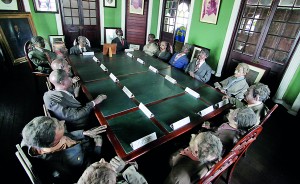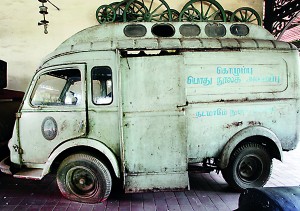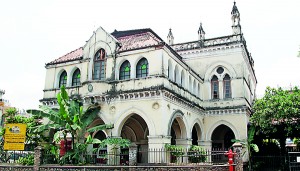Step into this room, and step back in time
The men sit around the table in solemn conference but they don’t mind when the caretaker W.A Samson interrupts to put a bucket on the table. On rainy days, the roof above the mannequins leaks and Samson is their first line of defence. Much of the beautiful old Town Hall building in Pettah is in a similar state of disrepair. Samson has watched its steady decline, having worked here for 28 years, his particular charge being the small museum adjoining the building. He keeps a key to the museum in his pocket and will only open it once he’s vetted you – the strategy adopted to thwart loiterers and crows, both old foes of his.

The ‘mock’ council in session. Pix by M.A. Pushpa Kumara
While time has flayed the commissioner’s coat, leaving it delicate and seemingly a touch away from falling apart, other exhibits in this museum appear invulnerable. The grand old steam roller, imposing and beautiful, is parked in one corner. While this is far from being the only one of its kind on the island, some of the other pieces sharing the space are truly unique. There’s Sri Lanka’s first mobile library – the blue lettering on the otherwise white van declaring it part of the ‘Colombo Public Library System.’Apparently, it’s the first steam truck to have been brought into Sri Lanka. It’s enormous, solid rubber tyres look like they could crush a bed of nails.
The room is small but it’s filled with interesting things – a post with street names on it, sewage transportation carts, a whole set of antique boilers and timers, light holders, taps, fans and machinery of every description and in one of the display cases there’s even a giant bulb. Gas lit, it used to stand at the centre of the junction outside. This single bulb was enough to light the entire area and is probably the only one of its kind left.The museum is a hit

The mobile library van
with schoolchildren who come to marvel, but visitors tend to be few here.
We wander into the main building, which now serves as an office for the fire brigade. Shiny red trucks are parked under the portico and firemen lounge around the rooms downstairs. The original staircase that links the two floors could use a polish, but on the upper floor it’s obvious the renovators have been at work. A large room has been cleaned up and painted, dark wainscoting lines the walls. This was where Bombay Velvet was filmed but the producers had all the work done.Unfortunately, they weren’t as interested in the rest of the building.
Further into the interior, the council room with its mannequins sits neglected. The dummies are placed so as to recreate a council meeting from 1906. Though you may have trouble recognising them, they’re reportedly meant to represent the likes of W. Shakespeare, P.D. Warren, Alexander Fairie and M.L.M. Zainudeen. Outside the room, a few antique typewriters seem to have escaped the museum to find a home upstairs. Against one wall, a map dating to 1785 stands, in it. Colpetty and Mount Lavinia are covered in coconut plantations. Samson’s colleague, H.D.P.W Gunasena shows us to the windows that once opened provide a panoramic view of Pettah. Set with painted glass, they run entirely on a system of ropes which still functions smoothly and efficiently. Looking out, all of Pettah lies before you and the wind catches your hair.
Bring back its old glory
Declared open by the British Governor Sir William Gregory in 1873, the old Town Hall building of the Colombo Municipal Council was designed by Architect J. G. Smither in 1868. Used for a period as a public market, it was restored under the auspices of B. Sirisena Cooray, Mayor of Colombo in the late 1970s. In December 1984, the late President J.R. Jayewardene declared it the Municipal Museum and Cultural Art and Trade Centre (some credit then Prime Minister Ranasinghe Premadasa for the project.) While the authorities are said to be interested in restoring the building, it will clearly require a significant investment. However, if successful, such a restoration will return the old Town Hall to a place of pride, which it has already earned by the beauty and grace of its structure and the indisputably valuable exhibits it houses. |


